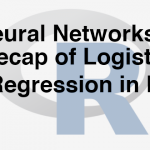
Choosing Optimal Model
In previous section, we studied about Model-Bias Variance Tradeoff
- Unfortunately there is no scientific method of choosing optimal model complexity that gives minimum test error.
- Training error is not a good estimate of the test error.
- There is always bias-variance tradeoff in choosing the appropriate complexity of the model.
- We can use cross validation methods, boot strapping and bagging to choose the optimal and consistent model
Holdout Data Cross Validation
- The best solution is out of time validation. Or the testing error should be given high priority over the training error.
- A model that is performing good on training data and equally good on testing is preferred.
- We may not have the test data always. How do we estimate test error?
- We take the part of the data as training and keep aside some potion for validation. May be 80%-20% or 90%-10%
- Data splitting is a very basic intuitive method
LAB: Holdout Data Cross Validation
- Data: Fiberbits/Fiberbits.csv
- Take a random sample with 80% data as training sample
- Use rest 20% as holdout sample.
- Build a model on 80% of the data. Try to validate it on holdout sample.
- Try to increase or reduce the complexity and choose the best model that performs well on training data as well as holdout data
Solution
- Caret is a good package for cross validation
library(caret)
sampleseed <- createDataPartition(Fiberbits$active_cust, p=0.80, list=FALSE)
train_new <- Fiberbits[sampleseed,]
hold_out <- Fiberbits[-sampleseed,]- Model1
library(rpart)
Fiber_bits_tree5<-rpart(active_cust~., method="class", control=rpart.control(minsplit=5, cp=0.000001), data=train_new)
Fbits_pred5<-predict(Fiber_bits_tree5, type="class")- Accuracy on Training Data
conf_matrix5<-table(Fbits_pred5,train_new$active_cust)
conf_matrix5##
## Fbits_pred5 0 1
## 0 31482 1689
## 1 2230 44599accuracy5<-(conf_matrix5[1,1]+conf_matrix5[2,2])/(sum(conf_matrix5))
accuracy5## [1] 0.9510125- Model1 Validation accuracy
hold_out$pred <- predict(Fiber_bits_tree5, hold_out, type="class")
conf_matrix_val<-table(hold_out$pred,hold_out$active_cust)
conf_matrix_val##
## 0 1
## 0 7003 1333
## 1 1426 10238accuracy_val<-(conf_matrix_val[1,1]+conf_matrix_val[2,2])/(sum(conf_matrix_val))
accuracy_val## [1] 0.86205- Model2
Fiber_bits_tree5<-rpart(active_cust~., method="class", control=rpart.control(minsplit=30, cp=0.05), data=train_new)
Fbits_pred5<-predict(Fiber_bits_tree5, type="class")
conf_matrix5<-table(Fbits_pred5,train_new$active_cust)- Accuracy on Training Data
accuracy5<-(conf_matrix5[1,1]+conf_matrix5[2,2])/(sum(conf_matrix5))
accuracy5## [1] 0.7882375- Model2 Validation accuracy
hold_out$pred <- predict(Fiber_bits_tree5, hold_out,type="class")
conf_matrix_val<-table(hold_out$pred,hold_out$active_cust)
accuracy_val<-(conf_matrix_val[1,1]+conf_matrix_val[2,2])/(sum(conf_matrix_val))
accuracy_val## [1] 0.79225- Model3
Fiber_bits_tree5<-rpart(active_cust~., method="class", control=rpart.control(minsplit=30, cp=0.001), data=train_new)
Fbits_pred5<-predict(Fiber_bits_tree5, type="class")
conf_matrix5<-table(Fbits_pred5,train_new$active_cust)- Accuracy on Training Data
accuracy5<-(conf_matrix5[1,1]+conf_matrix5[2,2])/(sum(conf_matrix5))
accuracy5## [1] 0.8673- Model3 Validation accuracy
hold_out$pred <- predict(Fiber_bits_tree5, hold_out,type="class")
conf_matrix_val<-table(hold_out$pred,hold_out$active_cust)
accuracy_val<-(conf_matrix_val[1,1]+conf_matrix_val[2,2])/(sum(conf_matrix_val))
accuracy_val## [1] 0.8661Ten-fold Cross – Validation
- Divide the data into 10 parts(randomly)
- Use 9 parts as training data(90%) and the tenth part as holdout data(10%)
- We can repeat this process 10 times
- Build 10 models, find average error on 10 holdout samples. This gives us an idea on testing error
K-fold Cross Validation
- A generalization of cross validation.
- Divide the whole dataset into k equal parts
- Use kth part of the data as the holdout sample, use remaining k-1 parts of the data as training data
- Repeat this K times, build K models. The average error on holdout sample gives us an idea on the testing error
- Which model to choose?
- Choose the model with least error and least complexity
- Or the model with less than average error and simple (less parameters)
- Finally use complete data and build a model with the chosen number of parameters
- Note: Its better to choose K between 5 to 10. Which gives 80% to 90% training data and rest 20% to 10% is holdout data
LAB – K-fold Cross Validation
- Build a tree model on the fiber bits data.
- Try to build the best model by making all the possible adjustments to the parameters.
- What is the accuracy of the above model?
- Perform 10 -fold cross validation. What is the final accuracy?
- Perform 20 -fold cross validation. What is the final accuracy?
- What can be the expected accuracy on the unknown dataset?
Solution
- Model on complete training data
Fiber_bits_tree3<-rpart(active_cust~., method="class", control=rpart.control(minsplit=10, cp=0.000001), data=Fiberbits)
Fbits_pred3<-predict(Fiber_bits_tree3, type="class")
conf_matrix3<-table(Fbits_pred3,Fiberbits$active_cust)
conf_matrix3##
## Fbits_pred3 0 1
## 0 38154 2849
## 1 3987 55010- Accuracy on Traing Data
accuracy3<-(conf_matrix3[1,1]+conf_matrix3[2,2])/(sum(conf_matrix3))
accuracy3## [1] 0.93164- k-fold Cross Validation building
- K=10
library(caret)
train_dat <- trainControl(method="cv", number=10)Need to convert the dependent variable to factor before fitting the model
Fiberbits$active_cust<-as.factor(Fiberbits$active_cust)- Building the models on K-fold samples
library(e1071)## Warning: package 'e1071' was built under R version 3.1.3K_fold_tree<-train(active_cust~., method="rpart", trControl=train_dat, control=rpart.control(minsplit=10, cp=0.000001), data=Fiberbits)
K_fold_tree$finalModel## n= 100000
##
## node), split, n, loss, yval, (yprob)
## * denotes terminal node
##
## 1) root 100000 42141 1 (0.42141000 0.57859000)
## 2) relocated>=0.5 12348 954 0 (0.92274052 0.07725948) *
## 3) relocated< 0.5 87652 30747 1 (0.35078492 0.64921508)
## 6) Speed_test_result< 78.5 27517 10303 0 (0.62557692 0.37442308) *
## 7) Speed_test_result>=78.5 60135 13533 1 (0.22504365 0.77495635) *prp(K_fold_tree$finalModel)Kfold_pred<-predict(K_fold_tree)
conf_matrix6<-confusionMatrix(Kfold_pred,Fiberbits$active_cust)
conf_matrix6## Confusion Matrix and Statistics
##
## Reference
## Prediction 0 1
## 0 28608 11257
## 1 13533 46602
##
## Accuracy : 0.7521
## 95% CI : (0.7494, 0.7548)
## No Information Rate : 0.5786
## P-Value [Acc > NIR] : < 2.2e-16
##
## Kappa : 0.4879
## Mcnemar's Test P-Value : < 2.2e-16
##
## Sensitivity : 0.6789
## Specificity : 0.8054
## Pos Pred Value : 0.7176
## Neg Pred Value : 0.7750
## Prevalence : 0.4214
## Detection Rate : 0.2861
## Detection Prevalence : 0.3987
## Balanced Accuracy : 0.7422
##
## 'Positive' Class : 0
## - K=20
library(caret)
train_dat <- trainControl(method="cv", number=20)Need to convert the dependent variable to factor before fitting the model
Fiberbits$active_cust<-as.factor(Fiberbits$active_cust)Building the models on K-fold samples
library(e1071)
K_fold_tree_1<-train(active_cust~., method="rpart", trControl=train_dat, control=rpart.control(minsplit=10, cp=0.000001), data=Fiberbits)
K_fold_tree_1$finalModel## n= 100000
##
## node), split, n, loss, yval, (yprob)
## * denotes terminal node
##
## 1) root 100000 42141 1 (0.42141000 0.57859000)
## 2) relocated>=0.5 12348 954 0 (0.92274052 0.07725948) *
## 3) relocated< 0.5 87652 30747 1 (0.35078492 0.64921508)
## 6) Speed_test_result< 78.5 27517 10303 0 (0.62557692 0.37442308) *
## 7) Speed_test_result>=78.5 60135 13533 1 (0.22504365 0.77495635) *prp(K_fold_tree_1$finalModel)Kfold_pred<-predict(K_fold_tree_1)Caret package has confusion matrix function
conf_matrix6_1<-confusionMatrix(Kfold_pred,Fiberbits$active_cust)
conf_matrix6_1## Confusion Matrix and Statistics
##
## Reference
## Prediction 0 1
## 0 28608 11257
## 1 13533 46602
##
## Accuracy : 0.7521
## 95% CI : (0.7494, 0.7548)
## No Information Rate : 0.5786
## P-Value [Acc > NIR] : < 2.2e-16
##
## Kappa : 0.4879
## Mcnemar's Test P-Value : < 2.2e-16
##
## Sensitivity : 0.6789
## Specificity : 0.8054
## Pos Pred Value : 0.7176
## Neg Pred Value : 0.7750
## Prevalence : 0.4214
## Detection Rate : 0.2861
## Detection Prevalence : 0.3987
## Balanced Accuracy : 0.7422
##
## 'Positive' Class : 0
## Bootstrap Cross Validation
Bootstrap Methods
- Boot strapping is a powerful tool to get an idea on accuracy of the model and the test error
- Can estimate the likely future performance of a given modeling procedure, on new data not yet realized.
- The Algorithm
- We have a training data is of size N
- Draw random sample with replacement of size N – This gives a new dataset, it might have repeated observations, some observations might not have even appeared once.
- Create B such new datasets. These are called boot strap datasets
- Build the model on these B datasets, we can test the models on the original training dataset.
Bootstrap Example
- Example
- We have a training data is of size 500
- Boot Strap Data-1:
- Create a dataset of size 500. To create this dataset, draw a random point, note it down, then replace it back. Again draw another sample point. Repeat this process 500 times. This makes a dataset of size 500. Call this as Boot Strap Data-1
- Multiple Boot Strap datasets
- Repeat the procedure in step -2 multiple times. Say 200 times. Then we have 200 Boot Strap datasets
- We can build the models on these 200 boost strap datasets and the average error gives a good idea on overall error. We can even use the original training data as the test data for each of the models
LAB: Bootstrap Cross Validation
- Draw a boot strap sample with sufficient sample size
- Build a tree model and get an estimate on true accuracy of the model
Solution
- Draw a boot strap sample with sufficient sample size
Where number is B
train_control <- trainControl(method="boot", number=20) Tree model on boots straped data
Boot_Strap_model <- train(active_cust~., method="rpart", trControl= train_control, control=rpart.control(minsplit=10, cp=0.000001), data=Fiberbits)
Boot_Strap_predictions <- predict(Boot_Strap_model)
conf_matrix7<-confusionMatrix(Boot_Strap_predictions,Fiberbits$active_cust)
conf_matrix7## Confusion Matrix and Statistics
##
## Reference
## Prediction 0 1
## 0 28608 11257
## 1 13533 46602
##
## Accuracy : 0.7521
## 95% CI : (0.7494, 0.7548)
## No Information Rate : 0.5786
## P-Value [Acc > NIR] : < 2.2e-16
##
## Kappa : 0.4879
## Mcnemar's Test P-Value : < 2.2e-16
##
## Sensitivity : 0.6789
## Specificity : 0.8054
## Pos Pred Value : 0.7176
## Neg Pred Value : 0.7750
## Prevalence : 0.4214
## Detection Rate : 0.2861
## Detection Prevalence : 0.3987
## Balanced Accuracy : 0.7422
##
## 'Positive' Class : 0
## Conclusion
- We studied
- Validating a model, Types of data & Types of errors
- The problem of over fitting & The problem of under fitting
- Bias Variance Tradeoff
- Cross validation & Boot strapping
- Training error is what we see and that is not the true performance metric
- Test error plays vital role in model selection
- R-square, Adj-R-square, Accuracy, ROC, AUC, AIC and BIC can be used to get an idea on training error
- Cross Validation and Boot strapping techniques give us an idea on test error
- Choose the model based on the combination of AIC, Cross Validation and Boot strapping results
- Bootstrap is widely used in ensemble models & random forests.
In next section, we will be studying about Neural Networks




